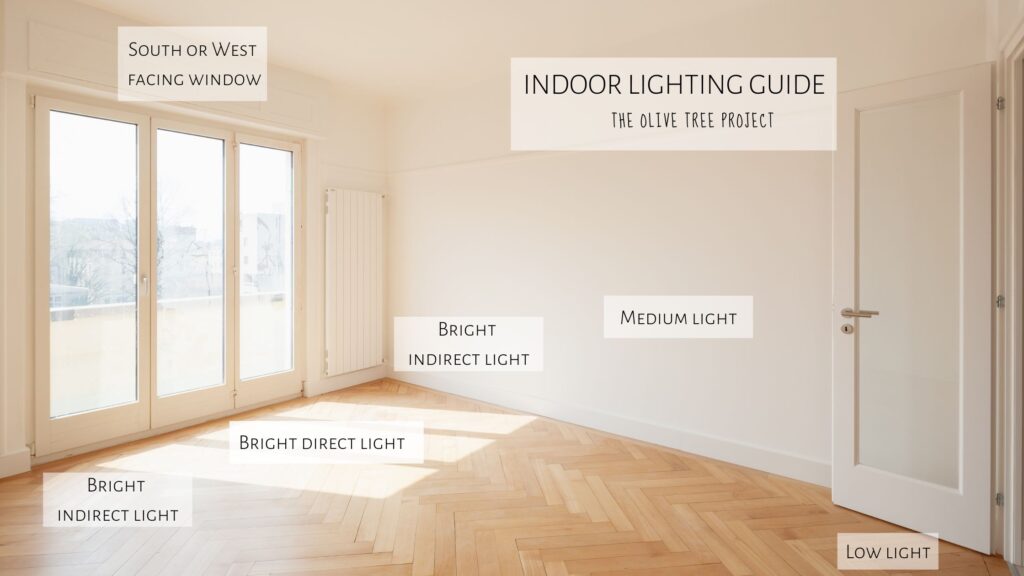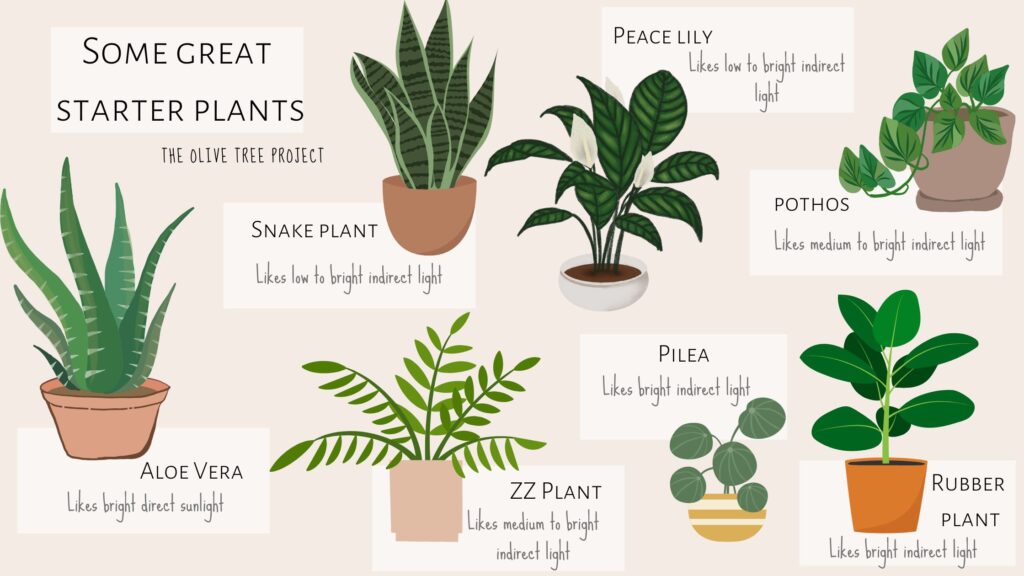So you want to get some greenery in your home and you’re not sure where to start. Here are some easy tips to help you become a successful plant parent.
Taking care of plants is very rewarding and a great way to connect with nature.
1. Assess the light in your home.
The first most basic need for any vegetation is sunlight. The type and amount of light that you get in a room will help you identify what will best thrive in your space. For example, southern facing windows that receive a full day of bright direct light is a great place for succulents, aloe vera and cacti.
So before even getting a plant, start to look at the natural light in your home. Observe your the windows, terrace and balcony, if you have them, and ask yourself the following questions:
- Which direction are the windows facing? (North/South/East/West)
- Does this space receive direct or indirect light?
- How does the light change during the day?
- How many hours of direct/indirect light does this space get?
- How does the light change in different seasons?
- Will the plant need to move spots depending on the season’s light?
General Rule:
- Southern facing – gets the most bright direct light throughout the day
- Eastern facing – gets cooler bright direct light in the morning
- Western facing – gets warmer bright direct light in the afternoon
- Northern facing – gets little to no direct light
*Note – The quality of light can change during the various seasons. This is because the height of the sun in the sky varies depending on the time of year and where you find yourself in the world.

Myth: Some plants don’t need light at all.
There is no such thing as a plant that doesn’t need light. They all need light as they all originated in nature. However, there are lots of plants that can easily thrive in medium amounts of light.
Tips for getting more light in your home:
- Mirrors – are a great way to increase light and increase the brightness in your home. Play around with the different placements, but we have found that placing a mirror on the perpendicular wall to a southern, eastern or western window, is a great way to increase the indirect bright light in the room.
- Artificial grow lights – For darker corners or northern facing areas in the home, adding an artificial grow light is a great way of creating a space where a greenery can thrive, despite the lack of light. Grow lights can get expensive, so before investing in lights to make a dark space brighter, we suggest that you utilize the brighter areas in your home. Once you’ve gained the confidence and knowledge of how to keep plant babies thriving in the brighter parts of the home, you can start to think about investing in grow lights.
2. Choose the right plant
Now that you know what kind of light options you’re working with, it’s time to get to the fun part – choosing a plant. As a newbie, we suggest to start off by getting one or two that are easy to care of. Once you get the hang of it, you can add more to your collection.
A very common newbie mistake is going to the nursery and buying lots and lots of plants in one go. More often than not, most of them will not have lasted a year because of their various requirements. Build your collection one step at time, learning all that there is to know about that one or two plants that you are taking home.
Do some research before even going to the shop. Find out which ones are easy to care for, fit your home’s lighting requirements and your aesthetic. While doing your research, consider species that are native to your area. Also if you have a pet, be sure to note, which might be toxic to your furry friends.
Go to the nursery with a plan. Have several options on your list and see what they have available. To recap, know the answers to the following questions when choosing the one to bring home:
- What kind of light does it need?
- How often does it need to be watered?
- Does it need specific soil?
- Does it like a more humid environment?
- Does it need specific fertilizer or special care?
- Is it native to my area?
- Is it toxic to animals?

3. To repot or not, that is the question
Do not fear repotting. Whether you want it to fit into your chosen house vibes or it’s time to size up your plant’s growth space, we’ve got you covered!
When to repot?
When you first bring home your new plant, it’s best not to repot it right away. This is because the it’s already experienced environmental changes coming from the nursery to the shop and finally to your home. It needs to acclimate to its new space and you don’t want to add other stressors like new soil or root damage. So place it in its intended space and let it adapt to its new home
If the nursery’s pot doesn’t fit into the color scheme of your space, you can hide it by placing the whole thing in another pot. Double potting typically uses what’s called a ‘cache pot’ as the exterior pot. This outer pot does not have irrigation holes at the bottom like the plant’s nursery pot, as its job is to hide the inner pot.
If you choose to double pot, just be aware of possible irrigation issues. Most plants don’t like sitting in water. To prevent this, you can either systematically remember to empty out the water of the outer pot after watering or you can place some gravel at the bottom of the cache pot, so that the plant is sitting on gravel.
General Rule:
The best time to repot is when it is starting its growth season. Typically this will happen in the spring. When you see it start noticing new growth, it will be more resilient to environmental changes. Another reason to repot is if you notice that the plant has become root bound. This means that it has outgrown its current pot. If this is the case, you’ll see roots circling the pot or coming out of the bottom irrigation holes.
Some tips when repotting:
- Choose a pot that’s about 2 inches bigger than the current pot
- Make sure that the new pot has irrigation holes at the bottom
- Take note of what the new pot is made of. Unglazed clay, ceramic or terracotta pots are permeable, which means the soil might dry out quicker and thus need a little more watering. Plastic pots retain more moisture and need a little less watering.
- Make sure you have the right type of soil mix for your plant. Plants like succulents and cacti need very well draining soil.
- Water your plant the night before repotting
- Repot your plant in the evening when the temperature is cooler
3. Watering
One of the easiest ways to kill plants is by over and/or under watering them. Having done your initial research, you should already have a general idea of the plant’s water requirements. Some variables that might tweak this a little is the amount of sun it gets in a day and the type of pot it’s in.
When assessing whether they need to be watered, observe and touch your plants. Touch the soil and notice how moist it is. Some plants, like the Pothos, will start to curl or droop when it needs to be watered.
Watering Tips:
- It’s best to water in the early morning
- Water until you notice it coming out of the drainage holes on the bottom
- Don’t let your plants sit in water
- Water more during the hot summer months and less in the cooler winter months
- Water the soil and not the leaves. The leaves don’t necessarily need to be watered or misted. The only reason to spritz a plant would be if it needs more humid conditions.
- Once you start having numerous plants, place the ones that have similar watering schedules near one another
4. Other care tips
- Fertilizing: Fertilizer puts nutrients back to the soil. So if you don’t fertilize your plants, they will likely become deficient in the long term. Indoor potted plants should be fertilized on a regular or semi-regular basis depending on the time of year. There are different types of fertilizers (natural vs chemical, liquid vs granular) that have different amounts of minerals. You can even make your own natural home fertilizers from items that you are already throwing out in the kitchen, like banana peels or egg shells.
- Regularly dust the leaves, so that they can efficiently absorb the light.
- Don’t be afraid to cut off dead leaves and faded flowers
- Keep an eye on your plant for disease or pests
- When your plant is thriving, learn how to propagate them into new baby plants.
> Find out how being in around nature helps your brain by clicking here.
> Find out about other ways to connect with nature by clicking here.
>Find out more about some good indoor beginner plants here.






